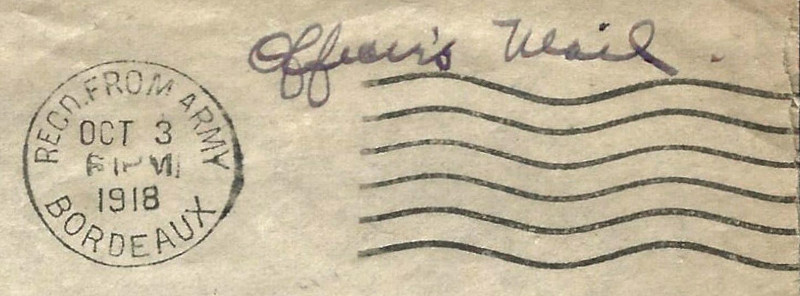
UMS 118 - The Bordeaux Story
This Article Originally Created by the late Robert Payne
The Bordeaux Terminal opened (adjacent to APO 705) when the MPES service was established on June 1, 1918, but the earliest known machine cancel is dated Aug 29, 1918. Two different dial dies have been identified, both used in 1918 and 1919. See the table and illustrations of die 1 and die 2 for assistance in identifying them.
A single specimen is known using a third dial die dated Jan 26, 1919. It has a very faint impression, and is shown with the notation "Bordeaux not excised".
Shortly after Jan 26, the "Bordeaux" appears to have been excised from the dial die. Three specimens of this configuration are known. See the illustration for more information. For many years no one has offered an explanation, but with the newly found specimen of this 3rd die, the following theory is offered for consideration.
It is our belief that the third die (and machine ?) was originally intended for use in Bordeaux to process the increasing mail load as our troop buildup continued. After the armistice, it was apparent that this would not be the case, and the machine was not needed because, in fact, the war was over, and the amount of mail would be diminishing rather than increasing. It is reasonable to assume, therefore, that the machine was sent to another location.
Consider the following. There was an examination of two covers with dial die 3 available at this time.
- 1. The 1st cover with a return address of the 109th Field Artillery, Ordnance Dept, which was a unit of the 53rd FA Brigade. This unit's APO was 744, and according to the Postal History of the AEF 1917-1923, Theo. Van Dam, 1979, mail went out via APO 712, the major Distribution Center in Is-sur-Tille.
- 2. The 2nd cover has a return address of the 312th Field Signal Battalion. The same reference gives this unit's APO as 755, and mail also went via the 712 Distribution Center.
Perhaps the machine with die 3 was used at APO 712 for a short time in 1919, after the war was over. Before any final conclusion can be made, additional specimens need to be examined and evaluated. [ed: Please send copies to the Machine Cancel Society, rather than Bob Payne, or Bart Billings.]
Class 10 -- Various Military Service Markings
| Type | Mfg | Postmark | Mach # | XCLN | EKU ymd | LKU ymd |
|---|---|---|---|---|---|---|
| UMS 118 | UN | Received From Army/Bordeaux die 1 | 1 | 300 | 1918 0829 | 1919 0424 |
| UMS 118 | UN | Received From Army/Bordeaux die 2 | 1 | 300 | 1918 0901 | 1919 0105 |
| UMS 118 | UN | Received From Army/Bordeaux die 3 | 2 | 300 | 1919 0126 | |
| UMS 118 | UN | Received From Army die 3 | 2 | 300 | 1919 0206 | 1919 0519 |
UMS 118
The 'Recd from Army' impressions made by the Universal machine(s), are mostly poor, exacerbated by the cheap paper which was used to make the wartime envelopes. Rather that be satisfied with early and late uses, as tabulated above, the list below is provided. It is a listing of all such cancels known to the author. Please send photocopies of any cancel in your collection.
Die 1 1918: 0930b 1009x 1016b 1026p 1107p 1114p 1124b 1129p 1130b 1216p Die 1 1919: 0104p 0117b 0218x 0221x 0323f 0410p 0418p 0424p Die 2 1918: 0901b 0914p 0916p 1230x Die 2 1919: 0105p Die 3 1919: 0126p with 'Bordeaux' very faint but not excised Die 3 1919: 0206y 0310p 0519y with 'Bordeaux' excised
The numbers above also give an indication of the scarcity. Die 3 is hands down the rarest marking, and there is only one known specimen with the 'Bordeaux' still in place, albeit very faint. So why was the 'Bordeaux' excised? From experience with other applications, one can assume that the die was moved to another location for use there.
The illustrations below are enhanced to better portray the actual configurations.
![[die 1]](http://machinecancel.org/pics/bordeaux1.gif)
|
![[die 2]](http://machinecancel.org/pics/bordeaux2.gif)
|
|
Die 1 note the wide space between 'X' of Bordeau and 'Y' of Army |
Die 2 Not as wide a space between 'X' and 'Y' of Army |
![[die 3 Bordeaux excised]](http://machinecancel.org/pics/bordeaux3.gif)
|
![[die 3 Bordeaux faintly visible]](http://machinecancel.org/pics/bordeaux4.gif)
|
| Die 3 with 'Bordeaux' excised | Die 3 'Bordeaux' not excised |
More Links
Contact information for the Society's President.
Updated 16 September, 2020
Original Updated October 16, 1999
Page Layout Design Made Possible by:
Vanilla.
Web pages designed and executed by
The Swanson Group
.